Biochar at the Centre for Alternative Technology: business opportunity for small woodland owners or climate change solution
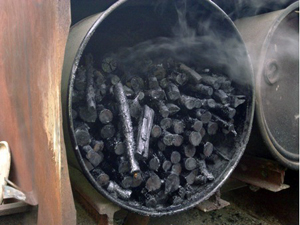
Biochar may be used to mitigate climate change brought on by global warming, by removing carbon dioxide from the atmosphere and locking the carbon into the soil, if James Lovelock (originator of the seductive Gaia hypothesis) is to be believed. Others say the numbers just don’t work. Biochar is also put forward as a very effective soil improver, which can reduce fertiliser use, reduce pollution, increase crop yields, and as an approach to agriculture may be traced back to the terras preta (black soils) of the Amazonian rainforest.
Woodlands’ Welsh team recently held its annual conference at the Centre for Alternative Technology (CAT), near Machynlleth (a fascinating and excellent location for a meeting) and were given an overview of how the method works, and the research being carried out at CAT. Grace Crabb is the resident biochar expert, who also manages and helps to lead the woodland management and green woodworking courses run by CAT. She is also the resident expert on water supply and sewage, and in her spare time looks after the geese!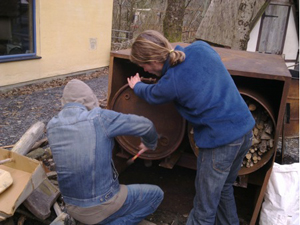
Biochar is charcoal created by pyrolysis of biomass. It differs from charcoal only in the sense that its normal use is not for fuel, but for capture (sequestration) and storage of atmospheric carbon capture. Charcoal is a stable solid rich in carbon content, and can be used to lock carbon in the soil. Biochar is of increasing interest because of concerns about climate change caused by emissions of carbon dioxide (CO2) and other greenhouse gases. Other approaches to carbon dioxide capture would tie up large amounts of oxygen and requires energy; biochar on the other hand, locks in the carbon captured by crops and trees, and releases the oxygen back into the atmosphere.
As a way of creating charcoal, the biochar process seems to be very efficient, and much quicker than traditional methods of creating charcoal. Although there isn’t a proven market, it may also be a business opportunity for small woodland owners to produce biochar for sale through local outlets as a soil improver.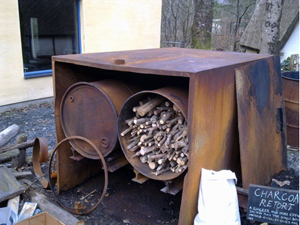
The retort used to produce biochar at CAT reuses three basic components: a metal shell to contain the fire (looks like an old oil tank), oil drums to contain the charcoal, and old railway track to support the oil drums over the fire. Pretty it isn’t, but looks simple and cheap to construct, and is very effective. Charcoal produced is about 70% of the volume of material loaded at the start, and unlike the traditional kiln method of charcoal production, the fire to drive the process is separate from the wood that is being converted to charcoal.
We gathered around the tank first thing in the morning (just after those geese were let out) and put the ends on the oil drums, the fire was lit underneath, and the process initiated. Water is driven off by the heat from the fire first, and then smoke colour changes as different by products are produced.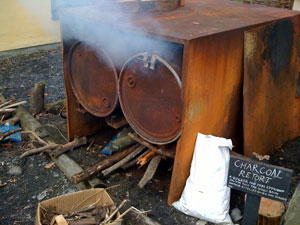 Gases are produced by the process, including methane that feeds the fire that drives the process. By 3.00 in the afternoon, the fire was out, the retort had cooled enough for us to remove the ends, and remove the charcoal.
Gases are produced by the process, including methane that feeds the fire that drives the process. By 3.00 in the afternoon, the fire was out, the retort had cooled enough for us to remove the ends, and remove the charcoal.
CAT will be carrying out tests on crop yields and tree growth resulting from applying biochar as a soil improver.
So, is it a solution to global warming? Maybe not, but the simplicity of the equipment, and the ability to make use of brash and other ‘waste’ material from a woodland makes it worth considering.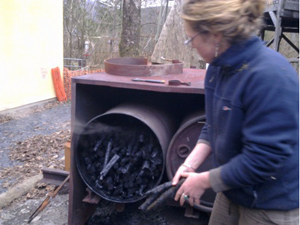
There are many sources of further information, but
- CAT produced a video about 18 months ago and
- Biochar Solution: Carbon Farming & Climate Change, by Albert Bates, seems to be well regarded.
Comments are closed for this post.
Discussion
Hello I got your web site from Craig Sams as I has asked him about Chargold and Worm farming and what were the benefits, disadvantages and if beneficial how do you use it in conjunction with the worm farming?
[…] Re: Mini charcoal retort – Mk2 The CAT kiln: Biochar at the Centre for Alternative Technology: business opportunity for small woodland owners or … […]
Hi, great article. I wonder if someone can give me some advice on purchasing or building a large Biochar unit. I am in Africa and interested in making charcoal from Hemp. This unit looks interesting as it seems something I might be able to put together myself on a larger scale. Anyone with ideas? Thanks a million.
Certainly the wood vinegar could be used but it has all sorts of nasty creosoles in it unless you clean it…
The exhaust gases are utilised to drive the burn. They are fed into the initial fire, speeding up the charcoal process. The potent greenhouse gasese methane and carbon monoxide burn to produce CO2 and water.
Polycyclic aromatic hydrocarbons will probably be present in the char, but you also get those from the domestic BBQ! Because we are burning the expelled gases we are less likely to get incomplete combustion so atmospheric PAH will be reduced.
Sorry about two lots- and now three – but my computer decided to flip and l thought l had lost the first part
l have been making biochar for two years and using it in the garden. I am aware that lump charcoal will eventually break down into small pieces given time but l think that the wider the spread in the soil, the easier it is for the plants to get at it. So l have been using sawdust. It took me several weeks of experimenting, and eventually, at a cost of about £200 l am now able to produce about 10 litres a day. I can get a free supply of sawdust, and so far l have made about 400 – 500 Litres. I burn it in a 25L inverted container inside a garden incinerator. Getting it in is fun because you have to stop the sawdust from fallingout. The gap between the two containers is filled with coarse sawdust and small pieces of wood. This is ignited from the top, sometimes with the help of a small amount of paraffin, and when it is burning properly, the incinerator lid is put on top. Virtually all the gasses are burned when they escape from the bottom of the container into the fire. They actually help with the burn. It takes about two hours and l leave it until the next day to cool down. I soak it in liquid manure made from dried chicken s–t pellets. I work it on a 24 hour basis from incinerator to soaking to draining and bagging. New biochar is not a fertiliser and if used without being primed wil take fertiliser from the soil. Biochar can be made from biomass which is effectively any biological material whether animal or vegetable. People all over the world are using a range of animal manures, including human waste. The plant marerials that can be used (and are) are so wide ranging that it would be impossible to list them all. Larger machines are being used and from these the gas is being collected and ussed to geneerate electricity and run motors. Some machines are huge, using all the waste collected by Councils. Some machines are small enough to be placed on a trailer and used in situ, which saves on transport costs, exhause emission etc. Do you have a compost heap? Place some biochar in this and in a wormery. The works love it. If you want to learn more Google – “terra preta”, “Biochar” to look up vast amounts of information. And if you look up”Transition Towns” you might already find someone near you already involved.
The charcoal here is of the lowest order and will allow most of the gasses to go free. I have been interested in this subject for a couple of years now and have been making biochar from sawdust. About 40% is turned into biochar and l hasve enough to fill a 2 gallon bucket every day (When the sawdust is available). I soak this for 24 hours in liquid manure as a primer, leave it to drain and store it in large polythene bags until needed. Sawdust made biochar spreads more evenly through the soil and is therefore more readily available to the plants.
This is very interesting and there is a load of stuff on the web. (Search for Biochar) As far as I can make out, what this process actually promises is to lock up some carbon for a reasonable time in a form which can be used as a soil improver.Effectively this limits its availability into the atmospheric side of the carbon cycle. I may be wrong but it is unclear how long the carbon is stable for. (Therefore its long term benefit) I think there are more efficient retorts around than the one shown at CAT – in some there is an element of distillation and capture of the “wood vinegar” which in turn is used as a soil enhancer, the distillation tube can also be diverted to feed the methane etc into the flames so ensuring more complete combustion (and presumably less environmental concerns). I am very tempted to give it a go as it seems a better option than either burning brash in bonfires or letting it decay naturally as part of the management of my woodland. The charcoal can also be added to compost toilets in small amounts and some people have been making charcoal urinals which use the urine to activate the charcoal, so that activated charcoal can be added to the soil. (Which is apparently better) Lots to think about.
This is an interesting possibility that probably does not add up to a real solution in the form practiced. As the article states pyrolysing the wood at the temperatures from a wood fire will produce an exhaust gas rich in water, methane, also carbon monoxide, carbon dioxide and probably hydrogen.
These gases are certainly not used up in the process but are going to be exhausted into the atmosphere, the oil cans must have an exhaust to let the gases escape or they would blow up. They will also produce other products commonly associated with incomplete combustion such as pahs (polycyclic aromatic hydrocarbons). These are toxic and some of them are considered to be responsible for lung cancer. They are found in cigarette exhaust (smoke), car exhausts and any imperfect combustion exhaust – even the wood fire used to drive this process will produce some. Though it is almost certainly correct that the carbon produced will be locked into the soil for decades, perhaps centuries or more – it is uncertain how much pah and other chemicals from pyrolysis may be locked into the carbon and released to the soil, and it is uncertain what the impact of the gas balance would be in an overall climate change calculation or a carbon footprint.
I would be very surprised if it were a clearly beneficial balance. It would require an analysis of the exhausts from the oil drum and the fire, analysis of the char and a mass balance to figure it out.
Well, the post speaks about “methane that feeds the fire that drives the process” – so methane ( a very potent ‘greenhouse gas’) is produced – but is used (up?) in the process.
However, more interesting is the statement biochar ….. “releases the oxygen back into the atmosphere”. Normally, the burning of organic materials such as wood / lignin / straw/ plant material (in general) uses up oxygen resulting in the formation of carbon dioxide; however, charcoal production is normally achieved in an oxygen poor / deficient environment, hence the carbonisation of the wood to charcoal – but it is not clear how this (biochar production) releases oxygen into the atmosphere, nor from where it derived.
The gases referred to in the report on charcoal. Would these be generated through normal burning or through normal biological degredation? If not what are the cosequences of releasing these gases into the atmosphere. It is not only CO2 that is a greenhouse gas.

[…] to tests being carried out at the Centre for Alternative Technology on crop yields and tree growth. Biochar at the Centre for Alternative Technology: business opportunity for small woodland owners or … Bear in mind that The Woodlands article is written for owners of woods and how they can benefit […]
Getting your seeds off to the best start this year - Page 17
13 May, 2013